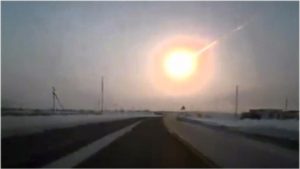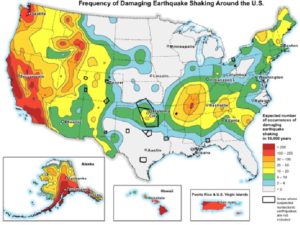“The unlikely combination of potatoes and pasta does appear in some Italian recipes.” Yotam Ottolenghi
People sometimes have a hard time appreciating the difference between risk and consequences. To help, we ask them to imagine the worst thing possible that could actually happen at their plant, but not to say what it is. Then we ask, “Is it worse than a meteor the size of a barn hitting the plant?”
It never is.
“Is it possible that a meteor the size of a barn could hit the plant?”
It is. “But…” they protest, “…it’s not very likely.”
Point made. Just as Chef Yotam Ottolenghi doesn’t worry about potatoes and pasta appearing in the same Italian dish, we don’t worry about meteors hitting the plant; they’re not very likely. Plant-destroying meteor strikes and palate-destroying potato and pasta dishes, although possible (that is, credible), are rare.
Does “Possible” Equal “Credible”?
People in the safety profession frequently distinguish between possible and credible. “No, we’re not really interested in the worst ‘possible’ case, we’re interested in the worst ‘credible’ case.” But then they don’t define credible. Like art, “you’ll know it when you see it.”
When it comes to events that people do not consider credible, meteor strikes are at the top of the list. Clearly, though, meteor strikes are possible. We do not have to go back 66 million years to the Chicxulub meteor that hit the Yucatan Peninsula in Mexico, killing off the dinosaurs (thus paving the way for us mammals to rule the world). Meteors enter the earth’s atmosphere all the time, although most are small enough that they burn up in the atmosphere before they get a chance to do any harm.
However, meteors large enough to do harm do strike the earth. Estimates vary, but it is fair to say that a meteor large enough to cause damage—shockwaves, disabled communications infrastructure, injuries, fatalities—like the meteor that exploded in the sky above Russia on February 15, 2013, occurs about once every 40 to 50 years with an impact zone of about 100 square miles. Fortunately, most of the earth’s surface is ocean or remote, unpopulated land.

Photo credit: http://www.pbs.org/wgbh/nova/earth/meteor-strike.html
The Chelybinsk meteor that exploded over Russia on February 15, 2013.
Can You Define “Credible”?
Just as most people would be quick to put meteor strikes on their list of the “not credible”, most people would be equally quick to put a plant in Kansas being hit by a tornado, or a plant in California being hit by an earthquake on their list of credible events. If we only knew how often those things happened, we could define “credible”. How rare is rare enough to not be credible?
When U.S. Supreme Court Justice Stevens wrote the majority opinion in the 1980 OSHA benzene case, he said, “Some risks are plainly acceptable and others are plainly unacceptable,” and then went on to add that the odds of fatality of one in a billion could not be considered significant but that for odds of a fatality of one in a thousand “a reasonable person might well consider the risk significant.”
It is not fair to expect mathematical rigor from a lawyer, even if he is a Supreme Court justice, so we can forgive Stevens’ choice of a window that is 6 orders of magnitude wide. Nonetheless, it is in that gap between once every thousand years and once every billion years that we will find the definition of “credible”.
What is the Likelihood of Rare Events?
Consider the three events listed above: plant-destroying meteor, plant-destroying tornado, and plant-destroying earthquake. (Let’s ignore the palate-destroying potato and pasta dish.)
Plant-destroying meteor: The surface of the earth is about 200 million square miles, meaning that the likelihood that a meteor strike destroys any specific plant is low:
1 event/50 years · 100 sq.mi. / 200 million sq.mi. ~ 1 event per 100 million years.
Already, we’ve narrowed Justice Stevens’ range by an order of magnitude.
Plant-destroying tornado: Unlike meteors, which can strike anywhere with equal likelihood, the likelihood of tornados is location dependent. An analysis of data published by FEMA indicates that plants in the most tornado-prone locations, such as parts of Kansas, can expect to experience destructive EF3, EF4, and EF5 tornadoes about once every thousand years. Plants in the least tornado-prone locations, such as in the Rocky Mountain or in Maine, need only expect these destructive tornados once every 100 thousand years. Perhaps we can narrow Justice Stevens’ range by another three orders of magnitude
Plant-destroying earthquakes: Like tornados, the likelihood of earthquakes is location dependent. The U.S. Geological Survey has prepared a map that shows zones going from “hot,” which has more than 250 destructive earthquakes per 10,000 years to “cool,” meaning less than 2 destructive earthquakes per 10,000 years. Coastal California, central Alaska and the Aleutian Islands, and the northwest corner of Puerto Rico are in the hottest earthquake zone, where a site can expect to experience one destructive earthquake per 40 years. The upper Midwestern United States and the Gulf Coast, on the other hand, are in the coolest earthquake zone, where a rate of once every 10 thousand years is more reasonable.

How Rare is Rare?
Justice Stevens suggested that once every billion years was rare. Our experience with meteors narrows that to once every 100 million years. Our experience with tornados in the Rockies, where we don’t consider them credible threats, suggests that once every 100 thousand years qualifies as rare, and our experience with earthquakes in the upper Midwest suggests that once every 10 thousand years qualifies as rare.
On the other hand, Justice Stevens suggested that once every thousand years is credible and our experience with tornadoes in the Midwest and Southeast is consistent that.
Define Credible
“Not credible” does not mean “not possible”. Yet defining “not credible” as “not likely” is no help, because it simply replaces one unquantified term with another unquantified term. It is only after you determine the frequencies of the events that you consider “credible” and the frequencies of events that you consider “not credible” that you can quantify “credible” for your organization. With that definition in hand, you will be able to eliminate scenarios that are “not credible.”
